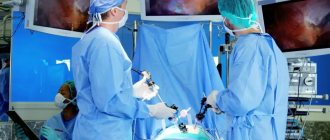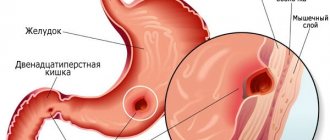Principles of nutrition
After closing an intestinal stoma, proper nutrition can significantly speed up the patient’s recovery process and prevent complications.
Dietary nutrition has the following principles:
- refusal to consume a number of prohibited foods;
- chewing thoroughly ;
- fractional meals - in small portions up to 5 times a day;
- a larger volume of food should be consumed for breakfast, lunch, and light dinner;
- compliance with the drinking regime - up to 1.5 liters of plain water per day;
- refusal of salt.
The greatest dietary restrictions occur in the period after surgery. When the functioning of the digestive system is fully restored, the list of permitted products will gradually expand. A return to the usual diet with minor restrictions is possible 1.5-2 months after the closure of the intestinal stoma.
The introduction of new products into the diet and expansion of the list of dishes should be done slowly and gradually. For several weeks after the stoma is closed, vegetables and fruits are prohibited; in the future, they will be introduced into the diet, first in boiled form, and then in raw form.
Thermal sparing also plays an important role in restoring the functioning of the digestive system, which means eating ready-made meals and drinks that are too hot or very cold, as they irritate the mucous membranes of the digestive system.
The first few days after the operation to close the intestinal stoma, the most gentle diet for the intestines is prescribed; these are dietary tables No. 0A, 0B, which involve eating only liquid and semi-liquid foods.
After 4-6 days, when the state of the digestive system began to normalize, the diet is gradually expanded, introducing a decoction of rice, low-fat, very weak broths, and jelly. After 1-2 weeks, the patient will be allowed to eat soups and ground meat dishes with pureed vegetables.
After being discharged from home, the patient switches to dietary table No. 4B - eating cereals and low-fat meat dishes, fermented milk and dairy products, vegetables and fruits.
Colostomy bags
Typically, patients with a colostomy use special bags called colostomy bags. Colostomy bags are designed to collect stool. They can be of different designs, disposable and reusable. The bag has a round base that adheres to the skin around the colostomy. Disposable bags are thrown away once filled. When using reusable colostomy bags, they are washed from feces and attached back. Reusable bags cause less damage to the skin when glued for a long time. Some colostomy bags are equipped with special deodorants to absorb the unpleasant odor that is uncontrollably released from the stoma opening.
You can also use a colostomy band with a hole. It is intended for the prevention of hernia in the stoma area. The bandage supports the abdominal wall after surgery. The colostomy opening usually has standard sizes or can be customized.
Patients can always contact specialists at the Yusupov Hospital for advice on the need for a colostomy, as well as methods of caring for it. The hospital employs experienced oncologists, surgeons, rehabilitation specialists, and nutritionists who provide treatment and postoperative therapy for patients with intestinal pathologies and cancer.
You can make an appointment with a specialist and get information about the work of clinics and the diagnostic center by calling the Yusupov Hospital.
Author
Yulia Vladimirovna Kuznetsova
Oncologist
What can you eat
The food after the ostomy is closed is varied and tasty if you correctly arrange the permitted products in the menu and use various recipes for their preparation.
What can be consumed after the closure of the intestinal stoma: various cereals, first in pureed form, after restoring the activity of the digestive system - in non-mashed form. Soups are allowed with vegetable broth or broth made from lean meats. The bread is only yesterday's bread, dried, baked from wholemeal flour.
Vegetables - any that do not cause gas, boiled or baked, or cooked in puree: zucchini and cabbage, beans, dill, carrots and potatoes.
Fruits: quince and pomegranate, pears, oranges, dogwoods, apples.
On this topic
- Digestive system
Differences between sigmoidoscopy and colonoscopy
- Natalya Gennadievna Butsyk
- December 9, 2020
Meat dishes - meatballs, cutlets, rolls, are prepared from lean meats and only steamed. Poultry meat – chicken, turkey. Rabbit meat, beef and veal are allowed.
Fermented milk products must be present in the diet: low-fat yogurt and kefir, sour cream, low-fat cream. Milk is recommended to be consumed only as an additive when preparing dishes.
Cereals cooked in water or milk: buckwheat, rice, oatmeal, semolina.
For sweets: hardened biscuit, dry, low-fat cookies, marshmallows, marshmallows, fruit marmalade, and jam are allowed.
After the stoma is closed, it is allowed to introduce pasta and noodles into the diet.
Drinks: preference should be given to decoctions that have a positive effect on peristalsis, for example, a decoction based on rose hips; fruit drinks are allowed. Juices – apple, cherry, pumpkin, always diluted with water. The use of cocoa prepared with water is allowed.
The menu for closing an intestinal stoma allows the use of boiled, soft-boiled, or hard-boiled eggs, or in steamed omelettes, but their quantity should not be abused. Eggs are consumed in quantities of 1-2 at a time, every other day.
The list of permitted foods when closing an intestinal stoma is generalized. Each patient selects those products that have a beneficial effect on peristalsis, since situations are possible when a person has an individual reaction to an approved product.
Diet after stoma closure
Oncologists at the Yusupov Hospital use modern diagnostic methods using equipment from leading global companies to diagnose malignant neoplasms. It is not always possible to perform radical surgery after a diagnosis has been made. In this case, surgeons create a stoma in the small or large intestine. After the stoma is formed, the stool is collected in a colostomy bag. Patients at the Yusupov Hospital are provided with dietary nutrition. The chefs prepare special dishes that have excellent taste.
What not to do
The diet after stoma reconstruction excludes the consumption of fatty foods, foods that can cause constipation, take a long time to digest and provoke a feeling of heaviness in the stomach.
It is forbidden to eat dishes that stimulate secretion - fatty meat broths, coffee.
Products that cause excessive gas formation are bread with bran, legumes. Vegetables with a high content of coarse fiber (cucumbers, turnips, radishes, garlic and horseradish, parsley, spinach) are excluded.
Prohibited fruits: melon, bananas, grapes.
On this topic
- Digestive system
The role of hormonal contraceptives in the development of liver hemangioma
- Natalya Gennadievna Butsyk
- December 6, 2020
Meat that should be excluded from the diet of a patient who has undergone surgery to close an intestinal stoma: pork, goose and duck.
Sausages and sausage products are excluded.
A categorical ban is imposed on mushrooms.
As for drinks, it is strictly forbidden to consume alcohol, especially beer. Carbonated and sweet waters and kvass are excluded from the diet. It is forbidden to consume apricot, plum and grape juices.
Confectionery and freshly prepared baked goods, chocolate, and ice cream are prohibited.
The menu after the ostomy is closed should not contain coarse foods and those dishes that require a long time to digest: smoked meats and marinades, canned meat, vegetables and fish, seasonings and sauces, fatty meat and fish.
When preparing dishes, you must avoid margarine, cooking fat, and vegetable oils.
In what cases is stoma removal surgery performed in Israel?
In most cases (more than 80%), the stoma is temporary - after cancer treatment in Israel and healing of the intestinal tissue, it is removed, restoring the natural way of excreting feces (through the rectum and anus). Occasionally, a stoma is permanent. This happens after resection of a significant part of the intestine, when there is no way to connect the intestine to the anus. This obstacle is not technically insurmountable, since there are a number of reconstructive techniques that can cope with the problem, but sometimes it is a question of the fact that the patient’s health condition prevents the operation - as a rule, this applies to severe cancer cases.
There are two ways to create an ostomy, depending on how much of the intestine was removed:
- Ileostomy – formation of a fistula of the small intestine;
- Colostomy is the formation of a fistula of the colon.
Restorative surgery after an ostomy consists of excision of an artificially created opening and suturing of the two ends of the intestine, restoring its patency along its entire length. Surgical techniques may differ depending on what part of the intestine is resected, and operations can be performed open or laparoscopically.
After surgery, it takes some time for the intestines to fully restore their functions, this can be a long process, from several months to a year or more, but ultimately in all patients who undergo reconstructive surgery after a stoma, intestinal functions are restored.
Restorative operations after an ostomy in Israel are routine, their risk is minimal, and in almost all cases they result in complete restoration of intestinal function. The approach of Israeli specialists is that even though a person gets used to the stoma, and over time, with proper care, it ceases to cause serious inconvenience, the quality of life without it is much higher.
Reconstructive operations after ostomy are one of the specializations of surgeons at Meir MC.
get a doctor's consultation
Sample menu
First day:
- Breakfast: oatmeal porridge cooked in milk, steamed omelet, weak black tea with milk.
- Second breakfast: some low-fat cottage cheese.
- Lunch: vegetable broth soup with the addition of pureed minced lean meat, pureed buckwheat porridge with water, juice or compote made from dried fruits.
- Afternoon snack: jelly made from non-acidic berries.
- Dinner: steamed lean fish cutlets baked in milk sauce, zucchini puree, weak tea, or cocoa with water.
- Before bed: a glass of low-fat drinking yogurt.
Second day:
- Breakfast: buckwheat porridge cooked in milk, soft-boiled egg, tea and crackers.
- Second breakfast: pureed cottage cheese.
- Lunch: vegetable broth soup with semolina and egg flakes, steamed chicken dumplings, pumpkin puree, rosehip broth.
- Afternoon snack: juice, biscuits.
- Dinner: fish cutlets, oatmeal with water, herbal tea.
- Before bed: a glass of yogurt.
The third day:
- Breakfast: oatmeal cooked with milk, a little low-fat cottage cheese, lean meat pate.
- Second breakfast: cookies with compote.
- Lunch: noodle soup cooked in chicken or vegetable broth, beef pate, fruit jelly.
- Afternoon snack: dried fruit compote or fresh fruit, biscuits.
- Dinner: fish soufflé covered with low-fat sour cream, pureed rice boiled in water, weak tea.
- Before bed: a glass of yogurt, or acidophilus.











